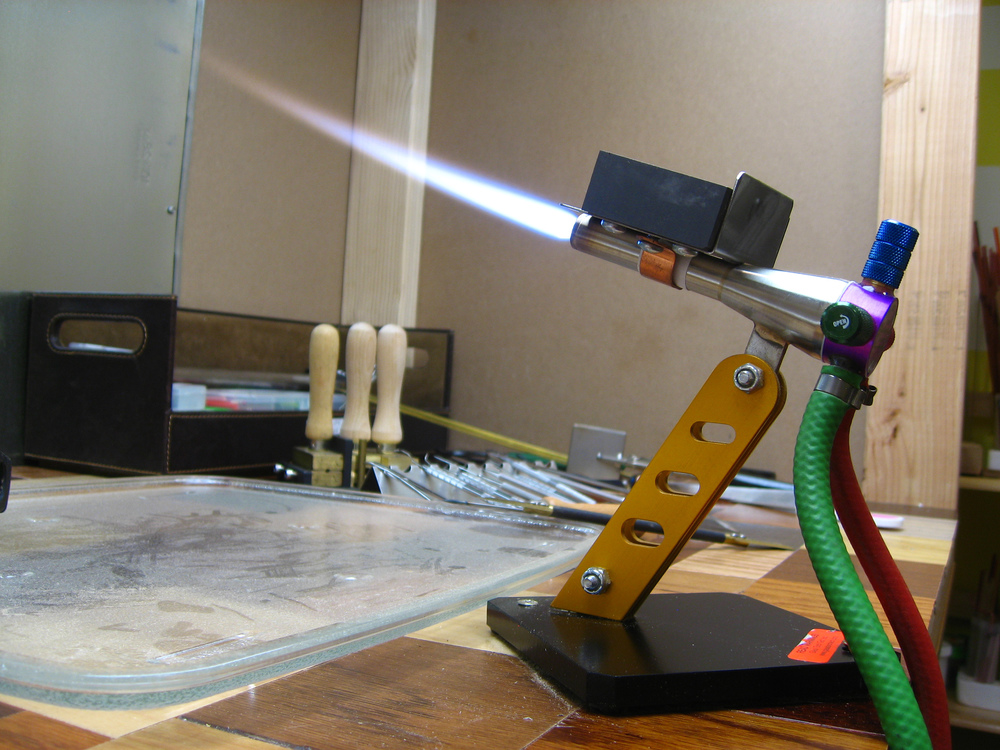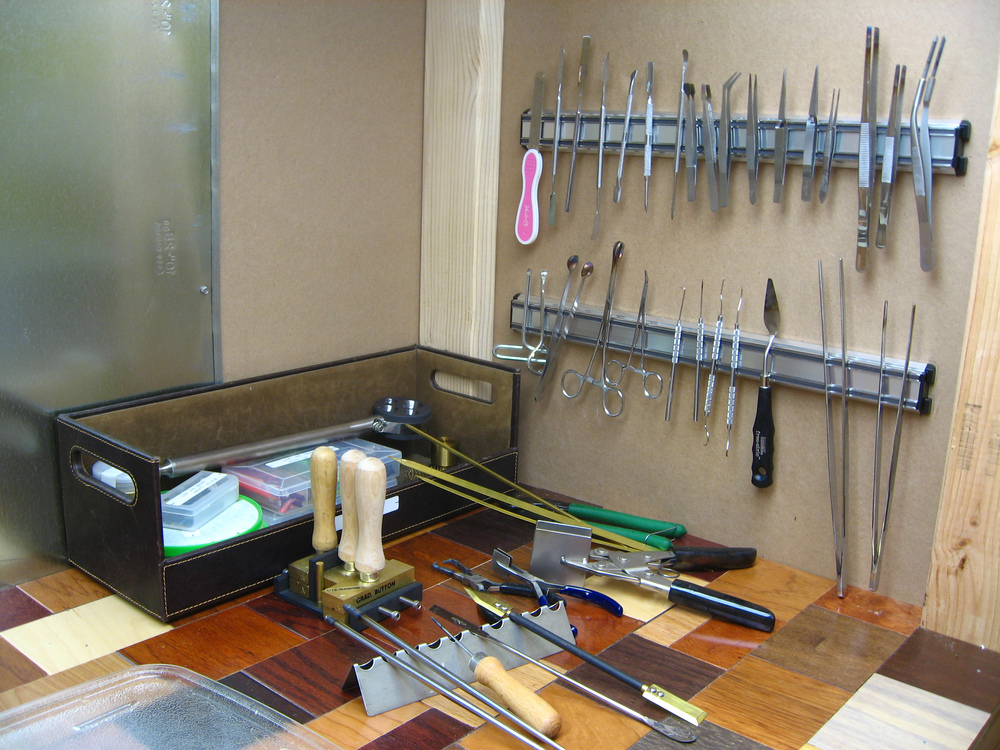I hope you have read my "Lampworking Safety" post. Here I am going to go into more detail on proper ventilation for your lampworking studio. Ventilation is a very complicated, but VERY important safety issue that most people do not spend enough time thinking about.
#Ventilation
This is an often overlooked topic. Ventilation is very, very important for lampworking! The fuel used to supply the torch flame (usually propane) does not combust completely, and so propane gas fumes may linger in the torch area unless the area is adequately ventilated. The flame also produces by-products of combustion including carbon monoxide and nitrous oxide. These must be actively removed, otherwise prolonged exposure will cause respiratory and irritant problems.
Additionally, the process of heating up glass releases metal fumes in the air. If you have ready my "Science of Glass" article, then you know that the colors of glass are due to transition metal impurities in the glass. When heated to molten hot temperatures, the metals are also fumed and released into the air. Heavy metal poisoning is a severe health danger associated with glassworking. Any other products that you use in your glass, including enamel or leaded frit, will also add to the ventilation problems.
The most dangerous products include NO2 nitrous oxide and CO carbon monoxide. NO2 is a severe respiratory irritant, while CO is highly toxic. Carbon monoxide is a colorless, odorless gas that displaces oxygen in your red blood cells' hemoglobin. Carbon monoxide poisoning is serious, which is why having a carbon monoxide detector in your lampworking space is critical.
To adequately ventilate your lampworking space, you must
- actively remove the fumes generated at the torch and also
- replace the air removed with clean air.
##To do this, you will need:
- A Fan - I have a hydroponic in line Max Fan. My fan is a 10 in inline fan, which is a little bit overkill. You can probably do with a smaller 6in or 8in inline fan. The smaller size is probably better actually because it was very difficult to find large diameter ducting, and I had to special order it. Six to eight inch diameter ducting should be available at a local home improvement store.
Edit: I have had a lot of people ask me about Fan recommendations. Here is a 10 inch inline fan similar to the one I have. I think the Can Fans and the Max Fans are very good. Alternatively, here is an 8 inch inline fan that is highly recommended. I would also get a rheostat of your choice.
If you want something a little bit smaller, here is a 6 inch inline fan. For this setup, I would also get a rheostat and some clamps.
They also make 12 inch and 14 inch inline fans, but honestly I think unless you are using this for a large teaching studio setup, this would be overkill. I think a 10 inch fan is plenty for individual use.
Ducting - You need to buy ducting the same diameter as your fan. I special ordered rigid 10in ducting. I choose rigid ducting rather than the collapsible flex ducting because flex ducting introduces more turbulence to the airflow in the duct, making it much louder. Rigid ducting greatly reduces the noise from excessive air velocity through the ducts, and is far superior than flex duct. If you go with rigid duct, make sure you buy elbow ducting as well for all of the corners you may have to traverse.
A silencer - I use a rheostat
to control the speed of my fan. My fan has only an On/Off, and you cannot adjust the speed of the fan to somewhere in between OFF and MAX. This is where my rheostat comes in. A rheostat is an adjustable resistor. It can control the amount of voltage going to an electronic device, like the fan, thereby adjusting the speed that the fan moves at. You can have infinite control with a rheostat, so instead of having just a Low/Med/High preset speeds, you can adjust to any speed from OFF to MAX. I needed the rheostat because my fan on the Max setting was much too powerful and too loud. (It would even propel itself off of its surface if not anchored down!) I now use the 10in inline fan at about 50% speed, and it is SO QUIET!
A way to contain fumes - Some people use a boot register or reducer in front of their torch to catch the fumes. Some people use a kitchen hood type of extractor. I personally have a custom built fully enclosed hood that is closed on 5 sides, with only the front open. The hood is similar in design to biological fume hoods used in laboratories for sterile culture. Because my 10 inch Max Fan is so powerful, I am able to construct a hood that covers my entire lampworking desk. You should calculate how much volume (in cubic feet) you will be able to extract with your setup (fan speed and ducting diameter and length). I like my setup, it allows me to have all of my tools on hand on my desk with no physical barriers, while working in a fully ventilated system.
An exit - Your ducting must directly to the outside to remove fumes and combustion by-products. I have my ducting exiting out a window in my room. I also had a window box built to disguise the ducting coming out of the window, since it is pretty industrial looking.
A return - Now that you have removed the "bad air," you will have to allow fresh good air to replace it in your work space. My setup is not perfect for this, since I have to work in a room attached to the main house (not recommended for fire safety purposes). I also have to work with the door closed to prevent cats from entering (cats plus flame plus glass beads do not mix!). Also, my room only has one window, which I have used for the exit ducting. Ideally, you will want fresh air coming from a second window (ideally on a different wall or area of the room as the exit ducting). As it stands now, I have my return air coming from under the two doors to the lampworking studio. The studio is under noticeable negative pressure as I work with the ventilation system on, so I know my return air is not sufficient to replace all the air exiting. So when you setup your lampworking studio, make sure you consider a good source of return air. An easy solution would be if you could work with an open window or open door behind you.
Conclusion
I hope this lampworking ventilation primer makes sense. My system might not be perfect, but it works very well for me, and seems very effective. You can use this as an example of what kind of ventilation works, but because each person's lampworking studio is different (size of available space, location of windows and doors, number of windows and doors, etc), each person's ventilation system will have to take into account all of those parameters. I advise you to seek professional advice before setting up a system. But if you have any general questions, I will be happy to answer if I can. Please comment below!





